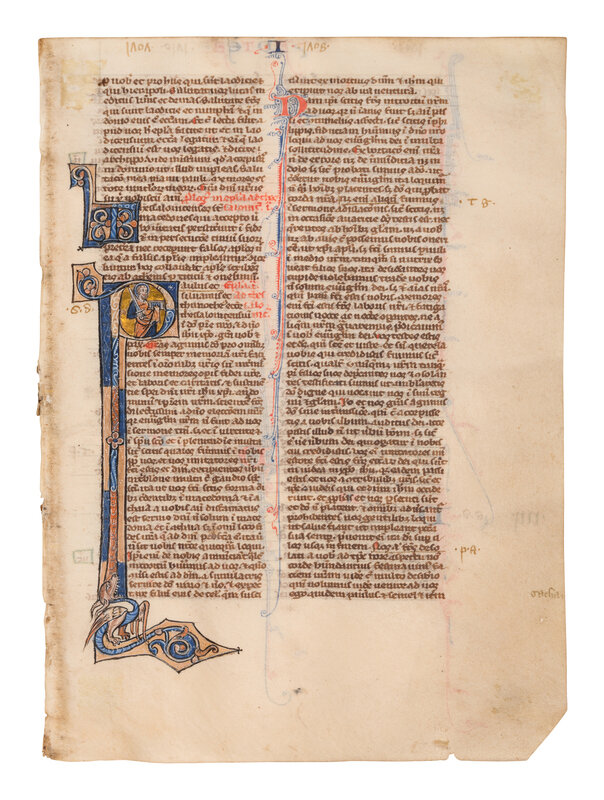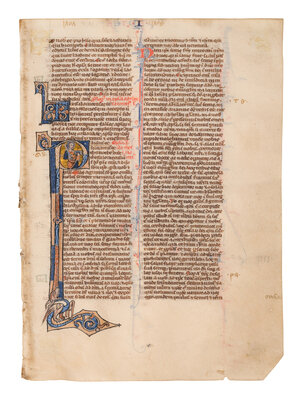Condition Report
Contact Information
Lot 10
CIRCLE OF WILLIAM DE BRAILES (active Oxford, c. 1230-1260)
A leaf from a Bible, with a historiated initial ‘P’ of St. Paul, in Latin, illuminated manuscript on parchment [England, Oxford (?), c. 1250-1275]
A leaf from a Bible, with a historiated initial ‘P’ of St. Paul, in Latin, illuminated manuscript on parchment [England, Oxford (?), c. 1250-1275]
Sale 2033 - Western Manuscripts and Miniatures
Jun 27, 2024
10:00AM CT
Live / Chicago
Own a similar item?
Estimate
$3,000 -
4,000
Price Realized
$3,493
Sold prices are inclusive of Buyer’s Premium
Lot Description
CIRCLE OF WILLIAM DE BRAILES (active Oxford, c. 1230-1260)
A leaf from a Bible, with a historiated initial ‘P’ of St. Paul, in Latin, illuminated manuscript on parchment [England, Oxford (?), c. 1250-1275]
A leaf from a Bible, with a historiated initial ‘P’ of St. Paul, in Latin, illuminated manuscript on parchment [England, Oxford (?), c. 1250-1275]
One of only two English artists whose names we can associate with known works in thirteenth-century England.
185 x 132 mm. Single leaf, columns numbered at the top “1707, 1708, 1709, 1710,” in brown ink in medieval Arabic numerals, ruled in plummet for two columns of 54 lines (written space: 133 x 90 mm), with an extra rule in the top margin for the running titles, written below top line in brown ink in a formal gothic bookhand, some marginal corrections framed in blue, capitals touched with red, rubrics in red, running titles and chapter numbers alternately in red and blue, one-line initials for chapters alternately in red and blue, numbered at the end of the preceding chapter with red and blue roman numerals, penwork bar border of alternately red and blue running the height of each column and extending into the upper and lower margins, four two-line initials alternately in red and blue on contrasting penwork, one four-line foliated initial in blue on light red ground, ONE SIX-LINE HISTORIATED INITIAL in burnished gold on blue, taupe, and russet checkered ground with white tracery, continued into the lower margin, with a four-petaled flower and a dragon (slight tape stains at the four corners, minor flake of gold in the initial, slight cockling of the parchment, pasted on passe-partout, else in good condition).
This leaf comes from a thirteenth-century Bible written in Oxford, which remained in the hands of English collectors throughout history (see below). It contains the end of Colossians and beginning of 1 Thessalonians, reading on the recto from Colossians 4:13, “…pro vobis, et pro iis qui sunt Laodiciæ,” to 1 Thessalonians 5:8 on the verso, “induti loricam fidei et caritatis…,” with two rubrics introducing the Prologue to 1 Thessalonians, “Thessalonicenses sunt macedones…,” and 1 Thessalonians itself. 1 Thessalonians is introduced with a large historiated initial P, for “Paulus,” with St. Paul in half-length holding sword and book on the ground of burnished gold leaf. The stem of the letter P continues into the lower margin and is terminated by a whimsical dragon looking up at Saint Paul.
Although the illumination is not in exactly the same style as William de Brailes’s signed works, the decorative repertoire is sufficiently close to his that we can safely suggest that it was painted in Oxford by a contemporary; they may have been neighbors in Catte Street. To take one example, the lower extension of the historiated initial has a dragon with wavy ears and an S-curve neck: this is very characteristic of de Brailes’s and other mid-thirteenth-century Oxford manuscripts. The penwork decoration of the chapter initials is not typical of de Brailes manuscripts, however and may suggest a date somewhat after the mid-century, during a transitional period between the use of simple flourishes, and the use of cascading “J” forms, alternately red or blue.
Leaves from this Bible are widely dispersed, recognizable by the very distinctive medieval Arabic numerals at the head of each column. The text does not have the numbering every fifth line that is sometimes found in Oxford manuscripts, but the numbering of columns serves a similar purpose: to allow rather precise references to sections of text, in an index or separate notes, for example. There are also marginal letters “a”–“g”, a common method of dividing pages into seven sections, a system apparently devised for use in the Dominican Concordance of St Jacques in the 1230s. The presence of both reference systems suggests that the book was being used for study, perhaps by an Oxford Dominican (the Dominican house was established in the city in 1221), and the Order has always been known for their biblical scholarship.
Provenance
(1) Bruce P. Ferrini (1949-2010), Akron, OH.
(2) Robert McCarthy, London, MS BM 1065c, acquired from him in 1996.
Parent manuscript
1. The present leaf comes from a Bible made for an unidentified Dominican (?) house: the parent volume had a note referring to use in the refectory (f. 107v) and the present leaf includes some added marginal notes indicating liturgical readings. It consisted of 402 leaves, illuminated with 55 large illuminated initials for prologues and 78 historiated initials.
2. The manuscript received scribbled names and ownership notes in the sixteenth century: William George, Robert Wyet, and Henry Consteny.
3. Charles Manning, based on a late-eighteenth or early-nineteenth century signature.
4. Charles Kirkpatrick Sharpe (1781-1851), Edinburgh, his signature on a flyleaf.
5. Sir John Jaffray (1818-1901), Scottish journalist and newspaper proprietor, his signature below Sharpe’s.
6. Sold at Sotheby’s, 14 October 1946, lot 147; bought by:
7. Alan G. Thomas (1911-1992), English bookdealer, reproduced by him in 1967 and kept for more than twenty-five years as part of his private collection;
8. Sotheby’s, 22 June 1993, lot 6, his posthumous sale; bought by:
9. Sam Fogg, London.
10.The manuscript was dismantled shortly afterwards, with this leaf sold as early as 1996 by Bruce P. Ferrini.
Sister leaves
Sister leaves with and without historiated initials are to be found in several public collections, including Cleveland Museum of Art (The Jeanne Miles Blackburn Collection 2011.53) and University of Iowa (Special Collections, MSC0542 xf mms. Bi3). A clutch of leaves including 27 historiated initials were saved from further dispersal by Scott Schwartz, New York. For a detailed list of further sister leaves, see Kidd 2018, pp. 59-67.
LITERATURE
On the present leaf and parent manuscript, published: Sotheby’s, London, 14-16 October 1946, lot 147; Sotheby’s, London, 21-22 June 1993, lot 6; Peter Kidd, The McCarthy Collection, Vol. II, Spanish, English, Flemish and Central European Miniatures, London, 2018, no. 11d, pp. 59-67 (with further literature).
We are grateful to Peter Kidd for permission to quote from his catalogue on this entry. Freeman’s | Hindman thank Senior Consultant Sandra Hindman and Elliott Adam for their assistance in preparing this sale.
The Collection of Robert McCarthy

